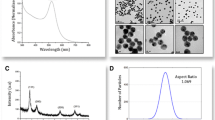Abstract
Gold nanoparticles (AuNPs) can be produced by well-assessed synthesis methods and can show a high surface area-to-volume ratio, chemical inertness, high electron density, strong optical absorption as well as low toxicity. AuNPs have been conjugated with many different biomolecules for a wide range of biomedical applications. These applications require an increasingly complex level of surface decoration in order to achieve stability, efficacy, and specific functionalities. This chapter provides detailed instructions about the synthesis of AuNPs and bioconjugation strategies in order to obtain stable hybrid nanomaterials. The described biofunctionalization procedures are based on carbodiimide chemistry and ligand-exchange methods allowing the conjugation of Lys-peptide or Cys-peptide, respectively, to the AuNPs surface.
Access this chapter
Tax calculation will be finalised at checkout
Purchases are for personal use only
Similar content being viewed by others
References
Dykman L, Khlebtsov N (2012) Gold nanoparticles in biomedical applications: recent advances and perspectives. Chem Soc Rev 41:2256–2282
Dykman L, Khlebtsov N (2017) Gold nanoparticles in biomedical applications. CRC Press
Aouidat F, Halime Z, Moretta R, Rea I, Filosa S, Donato S, Tatè R, De Stefano L, Tripier R, Spadavecchia J (2019) Design and synthesis of hybrid PEGylated metal monopicolinate cyclam ligands for biomedical applications. ACS Omega 4:2500–2509
Iarossi M, Schiattarella C, Rea I, De Stefano L, Fittipaldi R, Vecchione A, Velotta R, Ventura B (2018) Della colorimetric immunosensor by aggregation of photochemically functionalized gold nanoparticles. ACS Omega 3:3805–3812
Kim Thanh NT, Rosenzweig Z (2002) Development of an aggregation-based immunoassay for anti-protein A using gold nanoparticles. Anal Chem 74:1624–1628
Politi J, Spadavecchia J, Iodice M, de Stefano L (2015) Oligopeptide-heavy metal interaction monitoring by hybrid gold nanoparticle based assay. Analyst 140:149–155
Kim D, Park S, Jae HL, Yong YJ, Jon S (2007) Antibiofouling polymer-coated gold nanoparticles as a contrast agent for in vivo X-ray computed tomography imaging. J Am Chem Soc 129:7661–7665
Biju V (2014) Chemical modifications and bioconjugate reactions of nanomaterials for sensing, imaging, drug delivery and therapy. Chem Soc Rev 43:744–764
Zhou J, Ralston J, Sedev R, Beattie DA (2009) Functionalized gold nanoparticles: synthesis, structure and colloid stability. J Colloid Interface Sci 331:251–262
Frens G (1973) Controlled nucleation for the regulation of the particle size in monodisperse gold suspensions. Nat Phys Sci 241:20–22
Politi J, De Stefano L, Rea I, Gravagnuolo AM, Giardina P, Methivier C, Casale S, Spadavecchia J (2016) One-pot synthesis of a gold nanoparticle–Vmh2 hydrophobin nanobiocomplex for glucose monitoring. Nanotechnology 27:195701
Terracciano M, Napolitano M, De Stefano L, De Luca AC, Rea I (2018) Gold decorated porous biosilica nanodevices for advanced medicine. Nanotechnology 29:235601
Terracciano M, Shahbazi MA, Correia A, Rea I, Lamberti A, De Stefano L, Santos HA (2015) Surface bioengineering of diatomite based nanovectors for efficient intracellular uptake and drug delivery. Nanoscale 7:20063–20074
Patra HK, Banerjee S, Chaudhuri U, Lahiri P, Dasgupta AK (2007) Cell selective response to gold nanoparticles. Nanomedicine 3:111–119
Kumar N, Seth R, Kumar H (2014) Colorimetric detection of melamine in milk by citrate-stabilized gold nanoparticles. Anal Biochem 456:43–49
Palmieri G, Tatè R, Gogliettino M, Balestrieri M, Rea I, Terracciano M, Proroga YT, Capuano F, Anastasio A, De Stefano L (2018) Small synthetic peptides bioconjugated to hybrid gold nanoparticles destroy potentially deadly Bacteria at Submicromolar concentrations. Bioconjugate Chem 29:3877
Palmieri G, Balestrieri M, Capuano F, Proroga YTR, Pomilio F, Centorame P, Riccio A, Marrone R, Anastasio A (2018) Bactericidal and antibiofilm activity of bactenecin-derivative peptides against the food-pathogen Listeria monocytogenes: new perspectives for food processing industry. Int J Food Microbiol 279:33–42
Kinstler OB, Brems DN, Lauren SL, Paige AG, Hamburger JB, Treuheit MJ (1996) Characterization and stability of N-terminally PEGylated rhG-CSF. Pharm Res 13:996–1002
Turkevich J, Stevenson PC, Hillier J (1951) A study of the nucleation and growth processes in the synthesis of colloidal gold. Discuss Faraday Soc 11:55–75
Haiss W, Thanh NTK, Aveyard J, Fernig DG (2007) Determination of size and concentration of gold nanoparticles from UV-Vis spectra. Anal Chem 79:4215–4221
Merlino F, Carotenuto A, Casciaro B, Martora F, Loffredo MR, Di Grazia A, Yousif AM, Brancaccio D, Palomba L, Novellino E et al (2017) Glycine-replaced derivatives of [Pro3,DLeu9]TL, a temporin L analogue: Evaluation of antimicrobial, cytotoxic and hemolytic activities. Eur J Med Chem 139:750–761
Author information
Authors and Affiliations
Corresponding author
Editor information
Editors and Affiliations
Rights and permissions
Copyright information
© 2021 The Author(s), under exclusive license to Springer Science+Business Media, LLC, part of Springer Nature
About this protocol
Cite this protocol
Moretta, R., Terracciano, M., Rea, I., De Stefano, L. (2021). Bioconjugation of Peptides to Hybrid Gold Nanoparticles. In: Hussein, W.M., Stephenson, R.J., Toth, I. (eds) Peptide Conjugation. Methods in Molecular Biology, vol 2355. Humana, New York, NY. https://doi.org/10.1007/978-1-0716-1617-8_10
Download citation
DOI: https://doi.org/10.1007/978-1-0716-1617-8_10
Published:
Publisher Name: Humana, New York, NY
Print ISBN: 978-1-0716-1616-1
Online ISBN: 978-1-0716-1617-8
eBook Packages: Springer Protocols




